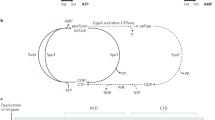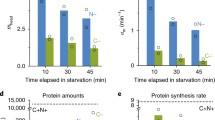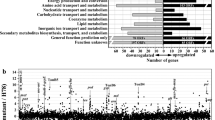Abstract
A fundamental question in microbiology is how bacterial cells manage to coordinate gene expression with cell growth during adapting to various environmental conditions. Although the cellular responses to changing environments have been extensively studied using transcriptomic and proteomic approaches, it remains poorly understood regarding the molecular strategy enabling bacteria to manipulate the global gene expression patterns. The alarmone (p)ppGpp is a key secondary messenger involved in regulating various biochemical and physiological processes of bacterial cells. However, despite of the extensive studies of (p)ppGpp signaling in stringent response during the past 50 years, the connection between (p)ppGpp and exponential growth remains poorly understood. Our recent work demonstrates that (p)ppGpp is strongly involved in regulating cell growth of Escherichia coli through balancing the cellular investment on metabolic proteins and ribosomes, highlighting itself as a magic governor of bacterial global resource allocation. In this mini-review, we briefly summarize some historical perspectives and current progress of the relation between (p)ppGpp and bacterial exponential growth. Two important future directions are also highlighted: the first direction is to elucidate the cellular signal that triggers (p)ppGpp accumulation during poor growth conditions; the second direction is to investigate the relation between (p)ppGpp and exponential growth for bacterial species other than E. coli.


Similar content being viewed by others
References
Bremer H, Dennis P (1996) Modulation of chemical composition and other parameters of the cell at different exponential growth rates. Escherichia coli and Salmonella, ed Neidhardt FC (Am Soc Microbiol, Washington, DC) 2:1553–1569
Castro-Cerritos KV, Lopez-Torres A, Obregón-Herrera A, Wrobel K, Wrobel K, Pedraza-Reyes M (2018) LC–MS/MS proteomic analysis of starved Bacillus subtilis cells overexpressing ribonucleotide reductase (nrdEF): implications in stress-associated mutagenesis. Curr Genet 64(1):215–222
Cook GM, Berney M, Gebhard S, Heinemann M, Cox RA, Danilchanka O, Niederweis M (2009) Physiology of mycobacteria. Adv Microb Physiol 55:81–182
Dai X, Zhu M, Warren M, Balakrishnan R, Patsalo V, Okano H, Williamson JR, Fredrick K, Wang YP, Hwa T (2016) Reduction of translating ribosomes enables Escherichia coli to maintain elongation rates during slow growth. Nat Microbiol 2:16231
Dai X, Zhu M, Warren M, Balakrishnan R, Okano H, Williamson JR, Fredrick K, Hwa T (2018) Slowdown of translational elongation in Escherichia coli under hyperosmotic stress. MBio 9:1
Dalebroux ZD, Swanson MS (2012) ppGpp: magic beyond RNA polymerase. Nat Rev Microbiol 10(3):203–212
Gaal T, Gourse RL (1990) Guanosine 3′-diphosphate 5′-diphosphate is not required for growth rate-dependent control of rRNA synthesis in Escherichia coli. Proc Natl Acad Sci USA 87(14):5533–5537
Gohara DW, Yap MNF (2018) Survival of the drowsiest: the hibernating 100S ribosome in bacterial stress management. Curr Genet 64(4):753–760
Gourse RL, Chen AY, Gopalkrishnan S, Sanchez-Vazquez P, Myers A, Ross W (2018) Transcriptional Responses to ppGpp and DksA. Annu Rev Microbiol 72:163–184
Hauryliuk V, Atkinson GC, Murakami KS, Tenson T, Gerdes K (2015) Recent functional insights into the role of (p)ppGpp in bacterial physiology. Nat Rev Microbiol 13(5):298–309
Hernandez VJ, Bremer H (1990) Guanosine tetraphosphate (ppGpp) dependence of the growth rate control of rrnB P1 promoter activity in Escherichia coli. J Biol Chem 265(20):11605–11614
Hernandez VJ, Bremer H (1993) Characterization of RNA and DNA synthesis in Escherichia coli strains devoid of ppGpp. J Biol Chem 268(15):10851–10862
Hui S, Silverman JM, Chen SS, Erickson DW, Basan M, Wang J, Hwa T, Williamson JR (2015) Quantitative proteomic analysis reveals a simple strategy of global resource allocation in bacteria. Mol Syst Biol 11(1):784
Klumpp S, Hwa T (2014) Bacterial growth: global effects on gene expression, growth feedback and proteome partition. Curr Opin Biotechnol 28:96–102
Klumpp S, Zhang Z, Hwa T (2009) Growth rate-dependent global effects on gene expression in bacteria. Cell 139(7):1366–1375
Klumpp S, Scott M, Pedersen S, Hwa T (2013) Molecular crowding limits translation and cell growth. Proc Natl Acad Sci USA 110(42):16754–16759
Krasny L, Gourse RL (2004) An alternative strategy for bacterial ribosome synthesis: Bacillus subtilis rRNA transcription regulation. EMBO J 23(22):4473–4483
Magnusson LU, Farewell A, Nystrom T (2005) ppGpp: a global regulator in Escherichia coli. Trends Microbiol 13(5):236–242
Monod J (1949) The growth of bacterial cultures. Annu Rev Microbiol 3(1):371–394
Murphy H, Cashel M (2003) Isolation of RNA polymerase suppressors of a (p)ppGpp deficiency. Methods Enzymol 371:596–601
Murray DK, Bremer H (1996) Control of spoT-dependent ppGpp synthesis and degradation in Escherichia coli. J Mol Biol 259(1):41–57
Paul BJ, Ross W, Gaal T, Gourse RL (2004) rRNA transcription in Escherichia coli. Annu Rev Genet 38:749–770
Potrykus K, Cashel M (2008) (p)ppGpp: still magical? Annu Rev Microbiol 62:35–51
Potrykus K, Murphy H, Philippe N, Cashel M (2011) ppGpp is the major source of growth rate control in E. coli. Environ Microbiol 13(3):563–575
Scott M, Hwa T (2011) Bacterial growth laws and their applications. Curr Opin Biotechnol 22(4):559–565
Scott M, Gunderson CW, Mateescu EM, Zhang Z, Hwa T (2010) Interdependence of cell growth and gene expression: origins and consequences. Science 330(6007):1099–1102
Scott M, Klumpp S, Mateescu EM, Hwa T (2014) Emergence of robust growth laws from optimal regulation of ribosome synthesis. Mol Syst Biol 10:747
Srivatsan A, Wang JD (2008) Control of bacterial transcription, translation and replication by (p)ppGpp. Curr Opin Microbiol 11(2):100–105
Steinchen W, Bange G (2016) The magic dance of the alarmones (p)ppGpp. Mol Microbiol 101(4):531–544
Sun D, Lee G, Lee JH, Kim HY, Rhee HW, Park SY, Kim KJ, Kim Y, Kim BY, Hong JI, Park C, Choy HE, Kim JH, Jeon YH, Chung J (2010) A metazoan ortholog of SpoT hydrolyzes ppGpp and functions in starvation responses. Nat Struct Mol Biol 17(10):1188–1194
Xiao H, Kalman M, Ikehara K, Zemel S, Glaser G, Cashel M (1991) Residual guanosine 3′,5′-bispyrophosphate synthetic activity of relA null mutants can be eliminated by spoT null mutations. J Biol Chem 266(9):5980–5990
You C, Okano H, Hui S, Zhang Z, Kim M, Gunderson CW, Wang YP, Lenz P, Yan D, Hwa T (2013) Coordination of bacterial proteome with metabolism by cyclic AMP signalling. Nature 500(7462):301–306
Zhu M, Dai X (2019) Growth suppression by altered (p)ppGpp levels results from non-optimal resource allocation in Escherichia coli. Nucleic Acids Res gkz211. https://academic.oup.com/nar/advance-article/doi/10.1093/nar/gkz211/5420536
Acknowledgements
This work was supported by the National Natural Science Fund of China (nos. 31700089, 31700039 and 31870028) and by self-determined research funds of CCNU from the colleges’ basic research and operation of MOE.
Author information
Authors and Affiliations
Corresponding authors
Additional information
Communicated by M. Kupiec.
Publisher's Note
Springer Nature remains neutral with regard to jurisdictional claims in published maps and institutional affiliations.
Rights and permissions
About this article
Cite this article
Zhu, M., Pan, Y. & Dai, X. (p)ppGpp: the magic governor of bacterial growth economy. Curr Genet 65, 1121–1125 (2019). https://doi.org/10.1007/s00294-019-00973-z
Received:
Revised:
Accepted:
Published:
Issue Date:
DOI: https://doi.org/10.1007/s00294-019-00973-z




